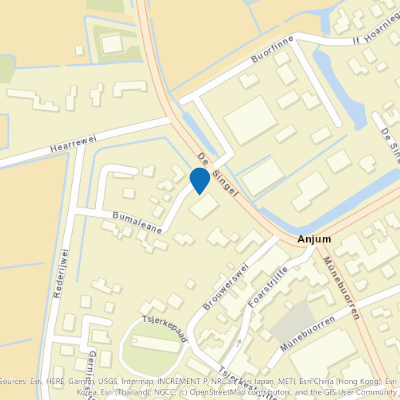Location
321 to 352 of 976 results
-
De Leijen - De Tike - Uitkijkhut
De Leijen - De Tike - Uitkijkhut Sumar
Sumar -
Huisjes aan het wad
Huisjes aan het wad Moddergat
Moddergat -
Slagerij Menno Hoekstra
Slagerij Menno Hoekstra Eanjum
Eanjum -
De Twirre
De Twirre Earnewald
Earnewald -
Yn't Paradyske
Yn't Paradyske Kollum
Kollum -
Haven De Dwinger Burum
Haven De Dwinger Burum Burum
Burum -
Veerpont De Wynser Oerset (Britsum/Stiens)
Veerpont De Wynser Oerset (Britsum/Stiens) Wijns
Wijns -
Treinstation Hurdegaryp
Treinstation Hurdegaryp Hurdegaryp
Hurdegaryp -
Eastermar | Laadpalen aan het water
Eastermar | Laadpalen aan het water Eastermar
Eastermar -
St. Nicholas Church Eastrum (Oostrum)
St. Nicholas Church Eastrum (Oostrum) Oostrum
Oostrum -
Heide State
Heide State Noordburgum
Noordburgum -
Mientjes Morgen
Mientjes Morgen Ferwert
Ferwert -
B&B Suupmarkt
B&B Suupmarkt Dokkum
Dokkum -
Hervormde Kerk Wierum
Hervormde Kerk Wierum Wierum
Wierum -
Schiermonnikoog - Westerplas - Vogelkijkhut
Schiermonnikoog - Westerplas - Vogelkijkhut Schiermonnikoog
Schiermonnikoog -
Noorderbegraafplaats
Noorderbegraafplaats
Vijftien geallieerde vliegers en vijftien verzetsslachtoffers vinden hun laatste rustplaats op de Noorderbegraafplaats in Leeuwarden. Ook worden er tijdens de Tweede Wereldoorlog bijna 450 gesneuvelde Duitse militairen begraven. Hun stoffelijke resten worden in 1958 overgebracht naar de Duitse oorlogsbegraafplaats Ysselsteyn.
Kort na het begin van de bezetting wordt de Noorderbegraafplaats aan het Leeuwarder Schapendijkje in gebruik genomen als militair ereveld. De eerste teraardebestelling van Duitse oorlogsdoden vindt er op 9 augustus 1940 plaats. Bij de bevrijding liggen op het Ehrenfriedhof bijna 450 Duitse militairen, die in 1958 collectief worden overgebracht naar de Kriegsgräberstätte Ysselsteyn bij Venray.
Het aantal geallieerde militairen dat vanaf juli 1941 op de begraafplaats een laatste rustplaats krijgt is qua aantal veel geringer. Nu nog liggen dertien Engelsen en twee Nieuw-Zeelanders begraven onder een rij karakteristieke witte headstones op regel 23 van de 2e afdeling. Oorspronkelijk waren er meer geallieerde oorlogsgraven. Twee Amerikanen en een Canadees zijn na de bevrijding herbegraven op de erevelden in Margraten en Holten.
In alle nu nog aanwezige geallieerde oorlogsgraven zijn bemanningsleden van vliegtuigen begraven. Van hen zijn alleen David Kay Foster en Robert Stanley Ling in de gemeente Leeuwarden gesneuveld. Hun Mosquito jachtbommenwerper stort op 28 mei 1944 neer op het vliegveld na een beschieting door luchtafweergeschut. De overige vliegeniers komen om een andere reden op de Noorderbegraafplaats terecht. Albert Hayes, Len Townrow en Michael John Boyle worden alle drie zwaargewond overgebracht naar het Bonifatiusziekenhuis en sterven daar ondanks de goede zorgen van de Duitse medische staf.
Jarenlang onderzoek door de Stichting Missing Airmen Memorial Foundation (SMAMF) in samenwerking met de Bergingsdienst van de Koninklijke Luchtmacht achterhaalt de identiteit van de zes gesneuvelden in het eerste graf. Het gaat om de bemanning van Wellington R1397. Het vliegtuig stort op 25 juli 1941 bij Boazum neer na een luchtaanval op Emden en is het eerste toestel dat crasht op het Friese vasteland. In 2015 zijn in aanwezigheid van nabestaanden twee nieuwe grafstenen met de namen van de bemanning door een legerpredikant ingezegend. De oude, naamloze, steen is nog te bezichtigen in het Fries Verzetsmuseum.
Ook liggen er vijftien verzetsslachtoffers begraven op de Noorderbegraafplaats, op een speciaal daarvoor ingericht ereveld. Op de grafmonumenten staat de tekst:
‘Fallen yn ‘e striid tsjin ûnrjocht en slavernij - dat wy yn frede foar rjocht en frijdom weitsje’
‘Gevallen in de strijd tegen onrecht en slavernij, opdat wij in vrede voor recht en vrijheid waken.’
Het meest in het oog springend zijn de drie zij aan zij geplaatste monumenten van de broers Mark, Klaas en Hyltje Wierda, die op 11 april 1945, enkele dagen voor de bevrijding, werden gefusilleerd bij Dronrijp.
De oorlogsgraven op de Noorderbegraafplaats zijn geadopteerd door vijf scholen uit Leeuwarden, die elk jaar op 15 april een herdenking organiseren.
Ook achter de grafmonumenten voor de Joodse familie Suskind (graf 03/-/24 /04) gaat een tragisch oorlogsverhaal schuil. MTS-leraar Willy Süskind stapte samen met zijn vrouw en zoon uit het leven, één dag na de Duitse inval in Nederland.
Helemaal achter op de begraafplaats herinnert een bijzonder grafmonument eveneens aan een oorlogsdrama. Het beeld van een treurende vrouw is geplaatst op het graf van Johanna Wilhelmina te Winkel en haar zoontje Hans, beiden slachtoffer van afgedwaalde bommen op de Julianastraat in 1942 (graf 04/1b/10).
 Leeuwarden
Leeuwarden -
Noarderleech Bunker and Training Base
Noarderleech Bunker and Training Base Hallum
Hallum -
Oostersingel
Oostersingel Noardburgum
Noardburgum -
Ypeymolen
Ypeymolen Ryptsjerk
Ryptsjerk -
Boer & Breakfast & Geitenboerderij De Sweach
Boer & Breakfast & Geitenboerderij De Sweach Kollumerzwaag
Kollumerzwaag -
Mokkebank - De Mok - Vogelkijkhut
Mokkebank - De Mok - Vogelkijkhut Mirns
Mirns -
Wadlopen Friese Wad
Wadlopen Friese Wad Nes
Nes -
Jachthaven en bootverhuur De Veenhoop
Jachthaven en bootverhuur De Veenhoop De Veenhoop
De Veenhoop -
Theaterkerk Nes
Theaterkerk Nes Nes (NEF)
Nes (NEF) -
Toutenburger bos
Toutenburger bos Noardburgum
Noardburgum -
Aanlegsteiger LM33A
Aanlegsteiger LM33A Driezum
Driezum -
Beauty en Sauna De Leeuwerikhoeve
Beauty en Sauna De Leeuwerikhoeve Burgum
Burgum -
Bêd en Brochje de Hollen
Bêd en Brochje de Hollen Ryptsjerk
Ryptsjerk -
Paard & Tuin Harstahof
Paard & Tuin Harstahof Ginnum
Ginnum -
Hervormde kerk (Hofkerk)
Hervormde kerk (Hofkerk) Hurdegaryp
Hurdegaryp -
Grutte Wielen
Grutte Wielen Leeuwarden
Leeuwarden -
Chaletpark de Lits
Chaletpark de Lits Eastermar
Eastermar

